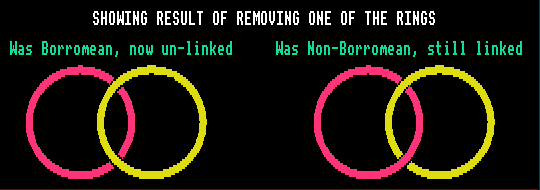


Carbon-12, in its excited isomeric state, is Borromean, because the three sub-units of helium-4 within its nucleus are bound together, whereas the two helium-4 sub-units in beryllium-8 are not bound. Strictly speaking, beryllium-8 isn't a nuclide at all because it is un-bound (possesses a positive not negative binding energy).
Those Borromean nuclei with neutron halos have two separate extra neutrons, but those with only one extra neutron cannot be Borromean, by definition. The neutron halo nucleus helium-6 with its helium-4 core and two separate extra neutrons is Borromean, as are the other neutron halo nuclides lithium-11, beryllium-14, and carbon-22. They are Borromean because their lighter cousins with just one extra neutron (lithium-10, beryllium-13, and carbon-21) are un-bound. Halo nuclei with just one halo neutron (like beryllium-11 and carbon-19) cannot be Borromean.
![]()